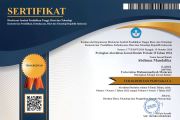Pemberdayaan Kelompok Perempuan Penenun dalam Pengembangan Ekonomi Lokal dan Pelestarian Budaya
Abstract
Abstract: Sabu weaving has its own attraction and has become an economic source for the Sabu community, especially women weavers. This service aims to empower women weavers so that they are able to adapt to the changing times, increase income and understanding in digital-based marketing, and maintain the preservation of Sabu weaving culture. The direct education and public assistance method involves involving the "Winirai" Weaver Women's Group which totals 16 people. The result of this service activity is the improvement of skills, the use of technology and marketing strategies through social media with the storytelling method with the strengthening of the narrative about the culture of Sabu Raijua weaving. In addition, this PKM realizes the preservation of the culture and heritage of Sabu weaving in increasing awareness of cultural values and weaving traditions among the younger generation.
Abstrak: Tenun Sabu memiliki daya tarik tersendiri dan telah menjadi sumber ekonomi masyarakat Sabu terutama perempuan penenun. Pengabdian ini bertujuan unuk pemberdayaan perempuan penenun sehingga mampu beradaptasi dengan perubahan jaman, meningkatkan pendapatan dan pemahaman dalam pemasaran berbasis digital, dan mempertahankan pelestarian budaya tenun Sabu. Metode edukasi langsung dan public assistance dengan melibatkan melibatkan Kelompok Perempuan Penenun “Winirai” yang berjumlah 16 orang. Hasil dari kegiatan pengabdian ini yaitu adanya peningkatan keterampilan, pemanfaatan teknologi dan strategi pemasaran melalui media social dengan metode storytelling dengan penguatan narasi menganai budaya dari tenunan Sabu Raijua. Selain itu PKM ini, mewujudkan pelestarian budaya dan warisan tenun Sabu dalam meningkatkan kesadaran akan nilai-nilai budaya dan tradisi tenun di kalangan generasi muda.
Keywords
Full Text:
PDFReferences
Bribin, M. (2022). Peran Perempuan Pengrajin Tenun Ikat Dalam Menyiapkan Generasi Penerus Di Desa Lobohede Kecamatan Hawu Mehara Kabupaten …. Jurnal Gatranusantara, 20(April), 124–133. http://publikasi.undana.ac.id/index.php/JG/article/view/g1394%0Ahttp://publikasi.undana.ac.id/index.php/JG/article/download/g1394/808
Chakraborty, P., Dasgupta, S., & Bhattacharya, A. (2024). Vernacular Architecture of Weaver’s Settlement—A Case for Creating Resilient and Sustainable Environments for Handloom Cluster at Bargarh, Odisha. In Advances in 21st Century Human Settlements: Vol. Part F3155 (pp. 1069–1081). https://doi.org/10.1007/978-981-99-8811-2_86
Das, A., & Paltasingh, T. (2024). Weaving as a Livelihood Option: A Study of the Bhulia Weaver Community in Odisha, India. Textile: The Journal of Cloth and Culture, 22(1), 180–200. https://doi.org/10.1080/14759756.2023.2175946
De Celis, I. L.-R., Velasco-Balmaseda, E., De Bobadilla, F. S., Alonso-Almeida, M. D. M., & Intxaurburu-Clemente, G. (2015). Does having women managers lead to increased gender equality practices in corporate social responsibility? Business Ethics, 24(1), 91–110. https://doi.org/10.1111/beer.12081
Gill, B. (2003). Eternal and enduring: Indian textile motifs. Embroidery, 54(5), 34–37. https://www.scopus.com/inward/record.uri?eid=2-s2.0-2342650034&partnerID=40&md5=34a098cdb1d0b888ed91bad21eede533
Gonzalez, R., & Mege, P. (2018). Analysis of Creative and Identity Processes among Mapuche Women Weavers in the Araucanía Region. Integrative Psychological and Behavioral Science, 52(4), 614–629. https://doi.org/10.1007/s12124-018-9456-4
Grover, V. (2015). Research Approach: An Overview. March.
Jennifer Agrilla, Krishna Hutama, & Yan Yan Sunarya. (2023). Akulturasi Material Tenun Sabu Serat Tencel. Jurnal Seni Dan Reka Rancang: Jurnal Ilmiah Magister Desain, 6(1), 45–60. https://doi.org/10.25105/jsrr.v6i1.17477
Karanika, A. (2020). Women’s tangible time: Perceptions of continuity and rupture in female temporality in Homer. In Narratives of Time and Gender in Antiquity (pp. 13–27). https://doi.org/10.4324/9781315145440-1
Kaya, Ö., & Romanescu, L. S. C. (2021). ROMANIAN FOLK SYMBOLS IN CONTEMPORARY FASHION DESIGN. New Design Ideas, 5(2), 135–149. https://www.scopus.com/inward/record.uri?eid=2-s2.0-85126822538&partnerID=40&md5=bcd80d7d4966bfbad95aeb5d60a16f23
Okpala, K. E., Mlanga, S., Nwajiuba, A. O., Osanebi, C., & Ezemoyih, C. M. (2019). Producers’ make or buy decision and business shutdown: An evaluation of choice in textile industry. Cogent Business and Management, 6(1). https://doi.org/10.1080/23311975.2019.1632568
Panjehbashi, E., & Torabi, S. M. (2022). Study of Animal Motifs of Sassanid Textile Design. Ancient Iranian Studies, 1(2), 97–112. https://doi.org/10.22034/AIS.2022.330912.1012
Pendit, 2002 dalam susiyati. (2018). Strategi Pengembangan Pariwisata Budaya Studi Kasus: Kawasan Pecinan Lasem, Kampung Lawas Maspati, Desa Selumbung. Jurnal Kajian Ruang, 1(2), 89–109. http://jurnal.unissula.ac.id/index.php/kr
Riwu, Y. F., & Kurniawati, M. (2023). Pelatihan Personal Branding Dan Digital Literacy Bagi Pelaku Umkm Di Kota Kupang. SELAPARANG: Jurnal Pengabdian Masyarakat Berkemajuan, 7(2), 1399–1406.
Selçuk, K., & Yurttaş, H. (2021). Geometric and Herbal Motifs Used in Kirkit Textiles from the Eastern Black Sea Region. Art-Sanat Dergisi, 15, 287–315. https://doi.org/10.26650/artsanat.2021.15.0012
Yudha Pramiswara, I. G. A. N. A., & Mardika, I. P. (2023). The ‘Jari Manis’ Strategy: Maintaining Ikat Weaving in the Midst of Weaver Regeneration Crisis in Julah Village, North Bali. Jurnal Kajian Bali, 13(1), 337–364. https://doi.org/10.24843/JKB.2023.v13.i01.p16
DOI: https://doi.org/10.31764/am.v4i4.33098
Refbacks
- There are currently no refbacks.
EDITORIAL OFFICE :













